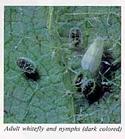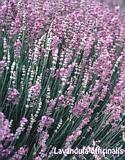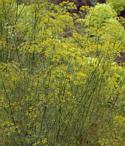
|
Organic Website Website
|
| Each kit contains 1 packet each of:
|
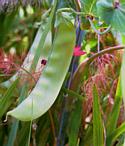 |
Controlling
Whitefly Naturally
by Arzeena
Hamir
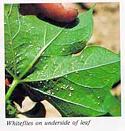
of the summer bring on a rush of new foliage growth, attracting
a wide variety of pests. Whitefly, one of the most difficult
pests to control, pose a special challenge to gardeners.
Whitefly numbers grow dramatically in the heat, most strains
are resistant to pesticides, and the pests infect a huge
range of hosts including bedding plants, strawberries,
tomatoes, and poinsettias.
Just as the name implies,
whitefly are small, fly-like insects with white coloured
wings. They hide on the underside of leaves where they
multiply rapidly. Whitefly feed on plant juices and,
in large numbers, can consume a considerable amount
of nutrients, causing plants to pale in colour. Like
aphids, they also excrete honeydew, attracting black
sooty mold fungus. Recently, these pests have been found
to spread viruses.
Identification
Although all whitefly
tend to look alike, there are two major types – greenhouse
whitefly and silverleaf whitefly (formerly sweetpotato
whitefly). The greenhouse whitefly has been recorded
on over 250 plants while the silverleaf whitefly attacks
over 500 hosts. Adult greenhouse whitefly are slightly
less than 1/8 inch long. They have a white, waxy coating
and hold their wings parallel to the leaf surface. Adult
silverleaf whitefly are slightly smaller than the greenhouse
whitefly and have a yellowish hue. They hold their narrow
wings at a 45-degree angle to the leaf surface.
Although not as prevalent,
other whitefly types include the bandedwing whitefly;
the spiraling whitefly which attacks star apple and
ornamental banana; the cloudywinged whitefly which can
infest citrus, gardenia and Ficus; and the citrus whitefly
which occurs on citrus and gardenia.
Life Cycle
Whitefly eggs are spindle-shaped and stand vertically
on the leaf surface. For many species, eggs are white
when first laid and turn dark grey (greenhouse whitefly)
or amber-brown (silverleaf whitefly) with time. Eggs
are deposited on the underside of leaves, sometimes
in a circle or crescent-shaped patterns. After hatching,
the “crawler” stage moves about on the plant looking
for a feeding site. At temperatures between 65 and 75F,
it takes less than 40 days to develop from egg to adult.
Mating is not necessary for egg production and a female
may lay up to 200 eggs.
Control Techniques
Thankfully, there are
a number cultural techniques and organic sprays to help
keep whitefly from over-running your plants. A combination
of these control techniques is the best method to keeping
whitefly numbers down.
Cultural Practices
When purchasing new plants,
inspect both the upper & lower surfaces. Preventing
whitefly infection this way saves headaches in the long
term. Floating row cover, placed over plants, will also
prevent them from becoming infected.
If you do find whitefly,
don’t panic! A cylinder vacuum can bring numbers down
considerably. Since the adult moths can fly easily from
one plant to another, do not place infested plant material
next to clean plants.
Sticky traps
Whitefly are attracted
to the yellow colour of sticky traps. For best results,
hang or place the cards close to the top of the plant.
Doors, vents and other openings where whiteflies can
enter greenhouses are other good sites to hang yellow
sticky cards.
Sprays
Whitefly began showing
resistance to synthetic insecticides in the 1980s. Sprays
containing pyrethrum or neem give the best control for
organic growers. Both the surface & the underside
of the leaf need to be covered and during the summer,
a spray regime every 5 days is required.
Biological Control
Agents
Encarsia formosa,
a small wasp, parasitizes to up to 100 immature greenhouse
whitefly each. Encarsia populations prefer temperatures
above 70 degrees F for development. The best time to
use Encarsia is between mid-March and mid-September.
Delphastus pusillus,
a small black ladybird beetle, will control both greenhouse
and silverleaf whitefly. The larvae will consume up
to 1000 whitefly eggs in its lifetime but will also
feed on nymphs. Like Encarsia, the beetles perform
best at temperatures between above 65F.
For more information on
whitefly, look to the following websites:
USDA’s Whitefly Knowledgebase
Information on silverleaf whitefly from the University of
Florida
Whitefly research at the University of Arizona
Arzeena Hamir is an agronomist
and garden writer based in Vancouver, BC. When she’s
not planting peas or harvesting zucchini, she runs Terra
Viva Organics – http://www.tvorganics.com/
Lavender
by Charlotte
J. Crockett
What do you imagine when you hear the word Lavender? Romance?
Smell? Herb? Sachets? Food?
Lavender (Lavandula).
It belongs in the mint (lamiaceae) family. Lavender
reaches the height of 24″ and the width of 18.” Its
flowers are either lavender, purple or white. The whole
plant from blooms to leaves is highly aromatic. It blooms
in midsummer. It is a perennial and is hardy in zones
5-9.
Native to the Mediterranean area, lavender likes hot,
dry summers and cold winters. There are some types of
lavender that are not hardy including French lavender
(only hardy to Zone 9-10) and Spanish lavender (Zone
7-9). Lavender prefers well-drained and full sun. This
plant is so versatile that it can be grown indoors as
a potted plant or in the garden.
In the spring, either
cut back last year’s growth or start lavender from seed
indoors. The seed will need 5-6 weeks cold stratification
and can sometimes take two weeks to a month for the
seeds to germinate. Fall is when you can divide lavender
for extra plants.
Lavender is an herb. It
not only smells wonderful, but it tastes just as good
as it smells. What better way to say romance than with
lavender and strawberries? Or, have a nice cool glass
of lavender lemonade on a hot sunny afternoon in the
garden.
To dry lavender, cut stems
to about a foot in length and tie with a string. Twist
the string around the stems to form a lavender bunch.
Hang to dry in a warm, ventilated area. When they are
dried, you can hang the lavender bunches from pegs in
your kitchen or any place you want the wonderful smell
around you. I keep a bunch sitting by my computer.
It is a known fact that
lavender helps relieve stress and headaches. At the
end of a day, enjoy a bath by adding drops of lavender
oil and bath salts to the water. Use a lavender sleep
pillow to help you fall asleep. In Victorian times,
lavender oil was used to perfume the body and the house,
to wash the floors and clean furniture, perfume the
linens, make potpourri and soap. We still use lavender
for all these purposes.
Culinary–pick
flowers/stems just as the flowers open. You can pick
leaves the anytime. Dry the lavender stems/flowers by
hanging in small bundles. You then can add flowers/stems
or leaves to vinegars, stews or jams.
Household–dry
the flowers to put into sachets. You can then use it
to scent drawers. Make a pin of the flowers and attach
it to your clothes to repel flies.
Cosmetic–lavender
water can be used against acne. Add into soaps, or as
an oil for muscle aches.
Medicinal — both
dried lavender (used as a tea) and lavender oil (one
drop on the temple) are used for headaches. It is known
to be a painkiller for insect bites.
I urge you to consider
having this wonderful plant in your garden. Even if
you don’t use it within your household, the smell of
it in your garden will be worth it.
For pictures of lavender,
use the following URL. My lavender addiction … lavenders
everywhere … http://www.aheb.com/garden/lavender/angustifolia.html
Natural
Weed Control
by Northern
Environmental Action Team
General Weed Killers
Vinegar This solution
will kill broadleaf plants as well as grass plants so
be careful of where you spray it. Mix together 3 parts
vinegar to one part dishwashing liquid. Spray the mixture
in a narrow stream on the weed’s leaves and the base
of the plant.
Boiling Water Boiling
water will kill any plant and seed it touches. Just
pour it on the plant, being careful not to splash on
any desirable plants.
Alcohol Mix 1 tablespoon
rubbing alcohol with 1 litre of water. Spray the mixture
on the weeds thoroughly but lightly. This will kill
all plants, so be careful of where you spray it. For
tougher weeds, you may need to increase the amount of
alcohol you use.
Dandelions
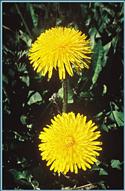
your lawn has by not letting the flowers go to seed.
Mow your lawn often to keep the flowers from maturing.
Dandelions thrive in acidic, compacted soil. Check the
pH of your soil with a home testing kit and adjust the
pH if necessary. In gardens, use a deep organic mulch
to reduce the dandelion population.
Physical Control
Hand dig out the plant, removing as much root as possible.
Spot treat the hole with boiling water. Spread grass
seed on the bare spot to prevent weeds from returning.
Quackgrass
Prevention Quackgrass
thrives in compacted soil with low organic matter. Make
your lawn inhospitable to the weed by aerating at least
once a year and by adding organic matter such as compost
to your soil.
If quackgrass is a prevalent
problem in your gardens, consider smothering the with
a cover crop. To do this, remove all desirable plants
from the problem area. Till the soil and broadcast buckwheat
seed over the entire area. Just before the buckwheat
flowers, till it under and reseed the area with buckwheat.
Repeat the till and seed process before the second growth
blossoms. In the fall, till the third stand of buckwheat
in and replant heavily with crimson clover. The next
year, allow the clover to flower and till it under.
The area is now ready to plant again.
Physical Control
Keep pulling it out. Make sure to get all of the root
as small pieces can sprout new quack grass. If mowed
regularly, the quackgrass population will decline.
Chickweed
Prevention The
presence of chickweed in your garden indicates frequent
tillage and high fertility. Reduce the frequency with
which you turn your soil and hold off on adding more
organic material.
Thistles
Prevention The
best way to prevent thistles is to use a heavy duty
mulch around gardens. Corrugated cardboard works well.
Cover the cardboard with a more decorative mulch if
you are concerned about the appearance of your garden.
Creeping Charlie
Borax Borax works
well on creeping charlie. Note: it may cause yellowing
of nearby grasses. If yellowing occurs, mow the grass
frequently and it should clear up within 6 weeks.
Mix together 5 teaspoons
borax and 1 litre of water. (measure the borax exactly-
too little won’t work and too much can kill your lawn)
Spray to cover a 25-square-foot area. Fertilize and
water the grass afterwards so it rapidly fills in the
space left by the weeds.
Even though these weed
control methods are natural, it is important to remember
that some of them can still be harmful to pets and children.
Store all mixtures out of reach of children and keep
animals and kids away from areas that have been treated
with a potent mixture
The Northern Environmental
Action Team website is located at http://www.prrdy.com/
Dill:
It’s not just a pickle spice!
By Brenda
Hyde
Dill is not only a pretty foliage plant; it’s fragrance
is a “comfort smell” for many people. I barely touch it’s
feathery leaves and the smell of homemade dill pickles,
crisp and savory, rubs off on my hands. At the same time,
dill is an herb that is often passed over as just a pickle
spice and is not truly appreciated.
Growing Dill
Dill can easily be grown from seed in full sun, and
can even tolerate a slightly sandy soil. However, when
first planting you should keep the soil moist until
established. Do not move your dill; instead plant where
you will be growing it. Thin the seedlings to 10 inches
apart; they will grow about 3 feet high. Use the seedlings
that you pull up; they are tender and delicious! Be
sure to let one of the plants remain with it’s seeds
after the season is finished, so it will reseed itself.
These plants will be much sturdier and hardier. Throughout
the summer you can plant dill in 2 week intervals also,
to maintain a supply of fresh leaves.
Using Dill
Dill leaf can be clipped
and used in cottage cheese, potato salad, cream cheese,
tomato soup and salads. You may also sprinkle chopped
young dill on broiling lamb, pork chops or steak during
the last five minutes of cooking. The seeds that form
on dill can be sprinkled on small pieces of toast or
crackers with salmon that has been mixed with mayonnaise.
Both the seed and leaf can be used in fish sauces. The
fresh leaves can be frozen in small resealable bags
and used in dishes. When the leaves are dried, they
are referred to as dill weed in recipes. The seeds can
be kept in a closed container and used as needed.
Cucumber and Sour Cream
Dressing
Ingredients:
- 1/2 cucumber, peeled,
seeded and grated (1/2 cup) - 1/4 tsp. salt
- 2 tsp. Dijon-style
mustard - 1 tablespoon vinegar
or fresh lemon juice - pepper to taste
- 1/2 cup sour cream
- 1/4 cup plain yogurt
- 1 tablespoon snipped
fresh dill
In a small sieve set over a bowl, toss the cucumber with
the salt and let drain for ten minutes. In a blender blend
the mustard, vinegar, pepper and salt to taste. Add the
sour cream, yogurt and the dill. Blend the mixture, scraping
down the sides until it is smooth. Add the cucumber and
blend until combined. Makes 1 1/2 cups.
Brenda Hyde is a wife,
mom, freelance writer and editor at seedsofknowledge.com For more
herb tips and recipes sign up for Herbs ‘N Spices, a
free newsletter, by sending any email to herbs-n-spices-subscribe@yahoogroups.com


